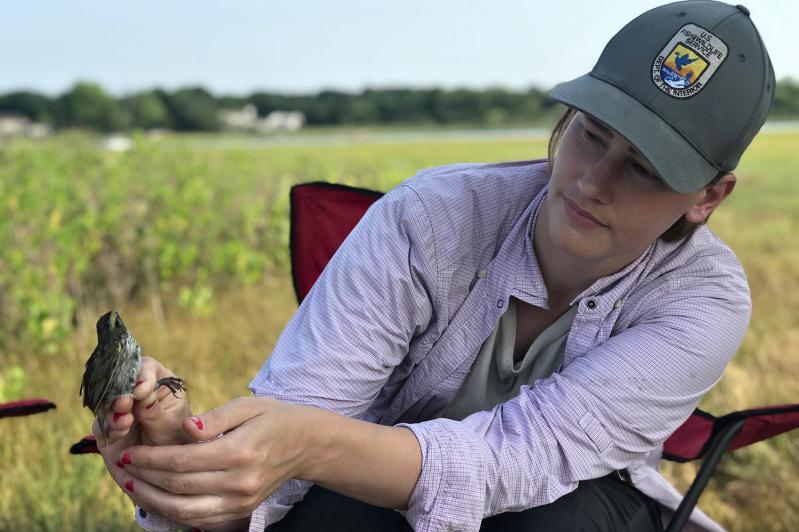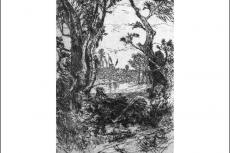Merrill Lake Sanctuary in Springs was already stifling at 8 a.m. on July 12, but despite the heat it was relatively crowded. Close observers might have noticed four cars parked along the road near the entrance, one with United States government plates.
The car belonged to Sam Apgar, a Ph.D. wildlife biologist with the United States Fish and Wildlife Service. She was deep in the saltmarsh that borders Accabonac Harbor wearing rubber boots that extended to her knees and sitting in a lawn chair as if it were as natural a landing place as the beach. She sat next to Nicole Maher, a senior coastal scientist with the Nature Conservancy, which owns the sanctuary.
A brown tarp stretched before them, shaded by an umbrella.
“We have birds in bags,” said Dr. Apgar, as a way of apology, for being so busy.
Indeed, easily missed in the odd scene were four white cloth bags full of saltmarsh sparrows, hanging in the shade of the umbrella, twitching with life.
East Hampton is downright lucky to have a population of saltmarsh sparrows, birds that are vulnerable because of their dependence on a habitat that shrinks with every centimeter in sea level rise: the salt marsh. The sparrows themselves are not so lucky. They’ve lost 75 percent of their population since 1990, according to the American Bird Conservancy, and “without intensive conservation will become extinct by 2050.”
The U.S. Fish and Wildlife Service is assessing whether the bird should be listed under the Endangered Species Act. The determination will be announced next year.
Saltmarsh sparrows are endemic to the East Coast. Their full life cycle occurs in the United States. “They spend their summers breeding here and winter in the Southeast United States,” said Dr. Maher. “This is the only population of them in the world.”
Dr. Apgar removed a bird from a bag. Saltmarsh sparrows have deep gray cheeks surrounded by pale orange, and dark-brown head stripes. Their upper chests are a similar, if paler, orange to their heads, and are streaked. Their bellies are white. For sparrows, they are long-billed and short-tailed. Holding its head between her middle and index fingers, her pinky and thumb holding down the bird’s wings, she attached a small nickel colored band to a thin piece of wire and slipped it around the bird’s tarsus: its ankle, basically. She blew on its belly to determine its gender. With a caliper she measured and read the totals to Dr. Maher.
“Right tarsus length, 55.5,” said Dr. Apgar. “Let’s do the feathers and weight.”
She carefully plucked three feathers from the bird’s breast, and handed them to Dr. Maher, who slid them into a small manila envelope which she labeled and licked shut. Dr. Apgar worked the bird into another bag, which looked as if it were made from pantyhose, and hung it from a scale. Ever hold four nickels in your hand? That’s about as much as a saltmarsh sparrow weighs. She removed the bird from the bag, as easily as one might pick up a piece of popcorn, walked just past the umbrella, and opened her palm. The bird flew low for 30 yards, before disappearing into some Spartina patens, high marsh grass.
“Ready for release condition,” said Dr. Maher.
“Normal release,” said Dr. Apgar.
To capture the birds, Dr. Apgar had spread six 12-meter mist nets in a U shape across the marsh. Six people slowly marched through Iva bush, into the Spartina grass, and over the crunchy looking Salicornia plants, which look like skinny pickles, and clapped their hands, herding the skulky birds into the nets.
Dr. Apgar ran from one tangled bird to the next, pried them free, and then placed each into its own cloth bag. “Each one is a different puzzle,” she said, hunched over a caught bird, disentangling it thread by thread. “Someone could try to shade the bird,” she said, before Dr. Maher, walked between the sun and bird, acting as a human shade.
“We’re excited to have Sam and the Fish and Wildlife Service,” said Dr. Maher. “These saltmarsh sparrows are the canary in the coal mine of marsh health.” She explained that a healthy marsh should be growing at a rate comparable to sea level rise. Each year, the marsh vegetation traps sediment, mud, and sand. As the plants grow, their roots and rhizomes below ground add bulk to the “marsh platform” giving the birds just enough room to nest without getting flooded.
“They’re hoping to catch that critical window between the highest high tides of the month. They can withstand some flooding of the eggs, which even float a little, but if they float out of the nest they’re lost. The mother bird can’t return them to the nest,” she said.
The marsh at the sanctuary is growing, but not as fast as sea level rise in the last 14 years it has been monitored. She said a group of organizations, including the East Hampton Town Natural Resources Department, the Peconic Estuary Partnership, and the Accabonac Protection Committee, were working on a minimally invasive plan to dig small drainage channels in the marsh. The work could begin as early as the fall.
Back at the mist nets, the women had captured a recent hatch. Dr. Apgar measured him first. “He’s just figuring out how to survive. I’ll give him a chance to get back to eating.” For a tense moment, after he was measured, the young bird did not leave Dr. Apgar’s hand. She placed it in the marsh grass and watched. Seconds later it flew away. “Delayed release,” she said.
“First year birds look like little flying pumpkins,” she said. “All black and orange.”
Dr. Maher was excited. “This is success. Proof that Merrill Lake is successfully breeding saltmarsh sparrows.”
Consider visiting. If you can brave the green-headed fly, walk past the purple martin house and into the marsh. Stand silently at the end, just past the largest trees. The marsh sparrows’ song sounds somewhat like the hiss of a hot pan hitting cold water, with some twitters. Watch them take short, low, flights across the tall marsh grass, and hope they hang in there.




